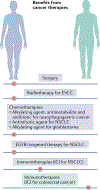Sex disparities matter in cancer development and therapy
- PMID: 33879867
- PMCID: PMC8284191
- DOI: 10.1038/s41568-021-00348-y
Sex disparities matter in cancer development and therapy
Abstract
Curing cancer through precision medicine is the paramount aim of the new wave of molecular and genomic therapies. Currently, whether patients with non-reproductive cancers are male or female according to their sex chromosomes is not adequately considered in patient standard of care. This is a matter of consequence because there is growing evidence that these cancer types generally initiate earlier and are associated with higher overall incidence and rates of death in males compared with females. Gender, in contrast to sex, refers to a chosen sexual identity. Hazardous lifestyle choices (notably tobacco smoking) differ in prevalence between genders, aligned with disproportionate cancer risk. These add to underlying genetic predisposition and influences of sex steroid hormones. Together, these factors affect metabolism, immunity and inflammation, and ultimately the fidelity of the genetic code. To accurately understand how human defences against cancer erode, it is crucial to establish the influence of sex. Our Perspective highlights evidence from basic and translational research indicating that including genetic sex considerations in treatments for patients with cancer will improve outcomes. It is now time to adopt the challenge of overhauling cancer medicine based on optimized treatment strategies for females and males.
Conflict of interest statement
Competing interests
The authors declare no competing interests.
Figures





References
-
- National Cancer Institute. SEER*Explorer. An interactive website for SEER cancer statistics https://seer.cancer.gov/explorer/(2020).
Publication types
MeSH terms
Grants and funding
LinkOut - more resources
Full Text Sources
Other Literature Sources
Medical

